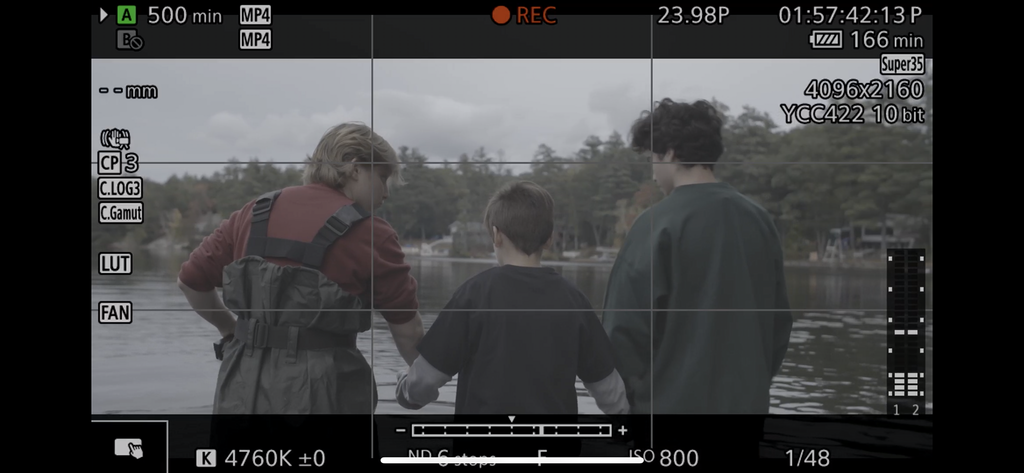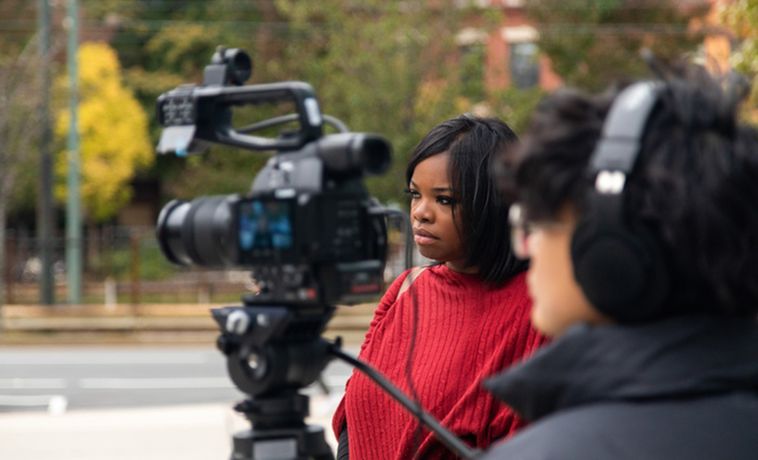
Lights! Camera! Borrow!
Field Production Services loans COM students all of the video, audio and lighting gear they need
A few times each semester, red carts loaded neatly with cameras, lights, and microphones line the hallway of COM’s basement. Film production students will soon swing by to collect the equipment they’ve reserved from the college’s gear library—called Field Production Services—and put it to work in class projects that will land in film festivals or launch industry careers. It’s fitting that posters from COM’s own Redstone Film Festival also line this hallway.
Field Production Services (FPS) manages thousands of pieces of equipment. Journalism students can borrow a digital SLR camera for an entire semester or check out a voice recorder. Advertising students can reserve lighting gear for a photo shoot. And film and television students can borrow, well, everything. There are diffusers and gels to control lighting; jibs, gimbals and dollies to create camera movement; and tripods, stands, clamps and sandbags to hold it all steady.
FPS by the Numbers
- Cinema and Video Cameras: 792
- DSLR Photo Camera
(semester loan): 198 - Audio Recorders: 501
- Microphones: 986
- Cinema Lenses: 1,656

Any COM student who needs equipment for a class project can make a reservation, as long as they’ve received training in advance. Brad Fernandes, COM’s director of technology, says his staff fulfilled 2,971 orders during the fall 2023 semester, loaning students 15,800 pieces of gear. While film productions make up the biggest orders, there’s a steady stream of students picking up and dropping off gear for smaller projects throughout the year.
Fernandes (CGS’99, COM’01) remembers when he was a student and COM had separate gear libraries for every department, each with its own rules. The system could be confusing for, say, a film student taking a journalism course. One of Fernandes’ first tasks when he joined the COM staff in 2009 was integrating all of the gear into FPS. Today, the biggest challenge is keeping up with the latest technology while also maintaining a collection that serves as many students as possible.
“We try to find the tools that can be used to teach students so that when they go out into the professional world, they’ll be able to make that transition,” he says. His staff stocks a fleet of modern cameras and is always planning for upgrades—like a shift to 4K video, which has four times the resolution of the high-definition cameras that make up most of the FPS collection.
Bret Upham, the manager of FPS, oversees the department’s daily operations. A veteran of the Boston filmmaking scene and a longtime instructor at the New England Institute of Art, he joined COM in fall 2023 and brings an educator’s eye to the job. More, and fancier, gear isn’t always the answer, he says. “In a learning environment, you should start with the bare bones and try to get a good shot with that.”




The students who reach Production III, COM’s honors level film production course, know how to get a good shot. Now they want them to look great. Theirs are the most complex reservations the FPS staff receives. And in fall 2023, no project was more complicated than Frére Jacques, a horror-thriller shot on location at Lake Monomonac in Rindge, N.H.
The film’s cinematographer, Mallory Holst (’24), says she visited FPS weekly that semester to test and borrow gear. “I’m kind of a gear junky,” she says. “I really like tech. As soon as I can get my hands on something, I want to know everything it can offer me.” For the team’s two weekend-long shoots, she checked out four carts full of gear, including specialized lenses and a slider for tracking shots. She estimates she borrowed $70,000 in equipment and had to rent a 15-foot U-Haul truck to transport it.


Frére Jacques, which tells the story of a family’s attempts to bring a dead child back to life, required filming inside a small A-frame house, outside on the shore of the lake and in the lake. “One of my main goals was to mix color temperatures—mixing warm tones coming from the inside and cool tones coming from the outside,” Holst says. “It really creates this spooky vibe and it creates depth within your frames.” To film in the water, she purchased fishing waders and a waterproof camera housing. A stunt coordinator was hired to supervise and a crew member with lifeguard certification stood by.
Several months after wrapping up filming, Holst and the rest of the Frére Jacques crew are making final edits, tweaking the colors and preparing to enter festivals. At FPS, the staff is getting organized to start the cycle all over again, as the next group of filmmakers prepare their reservations.



